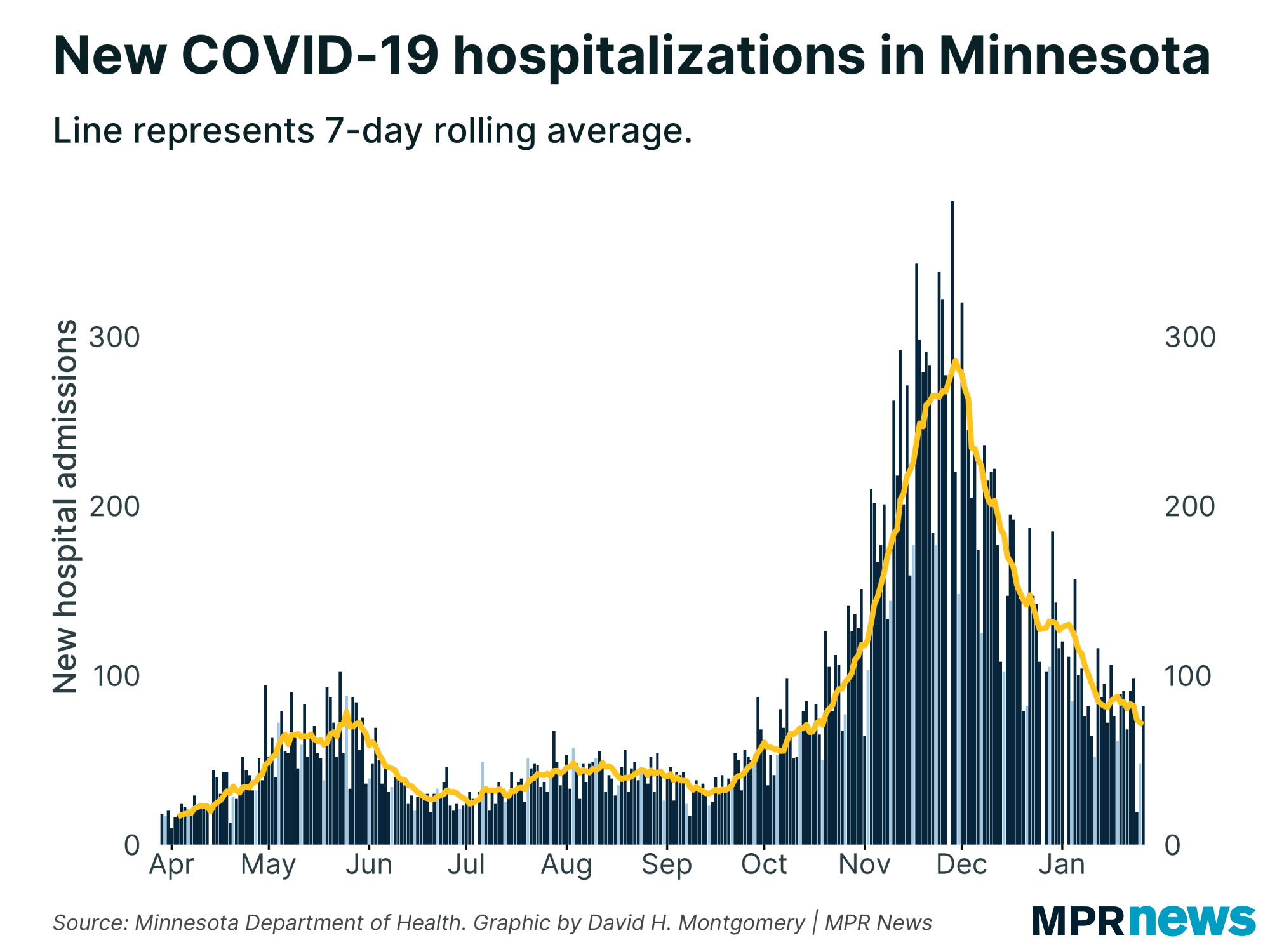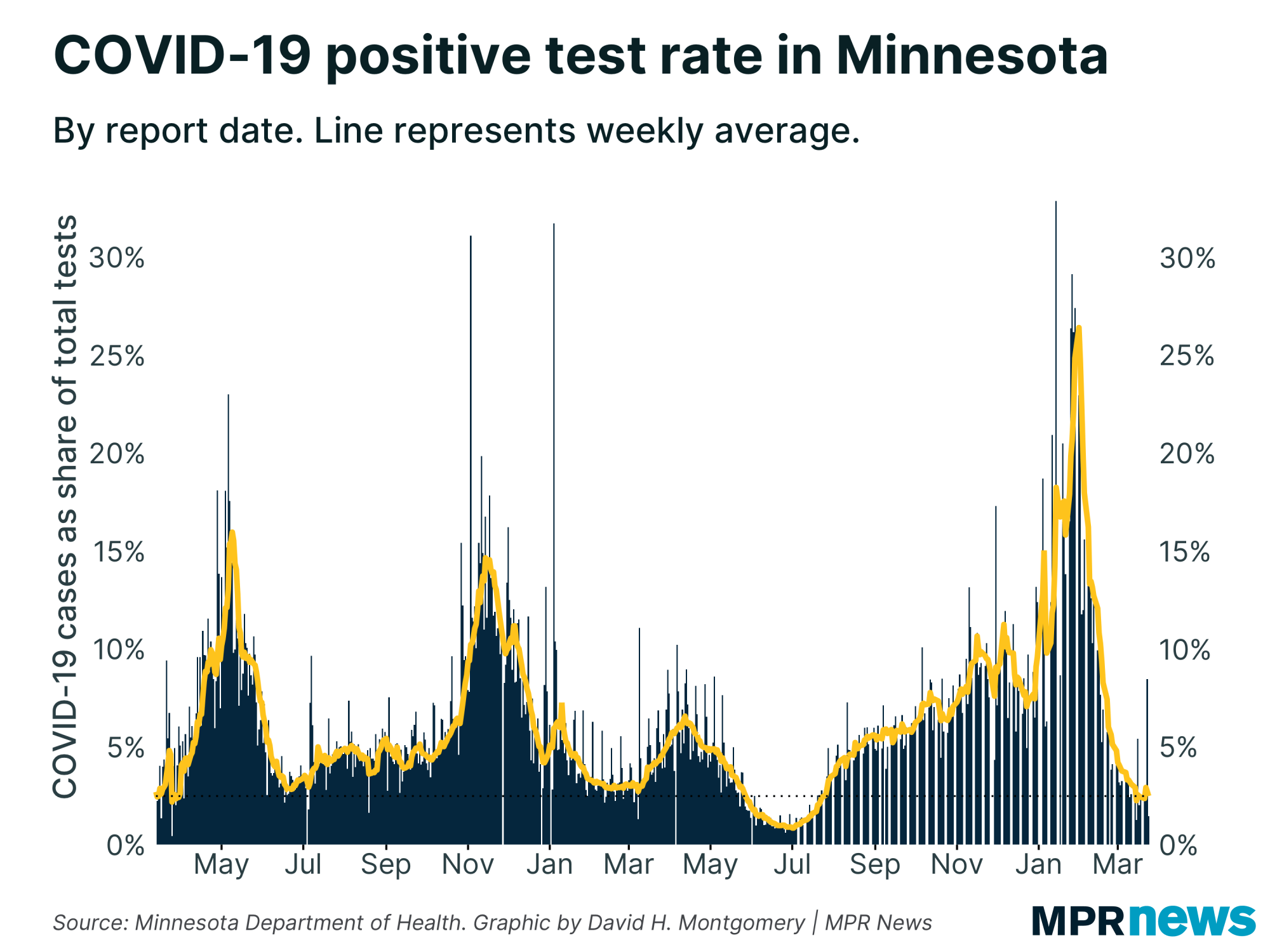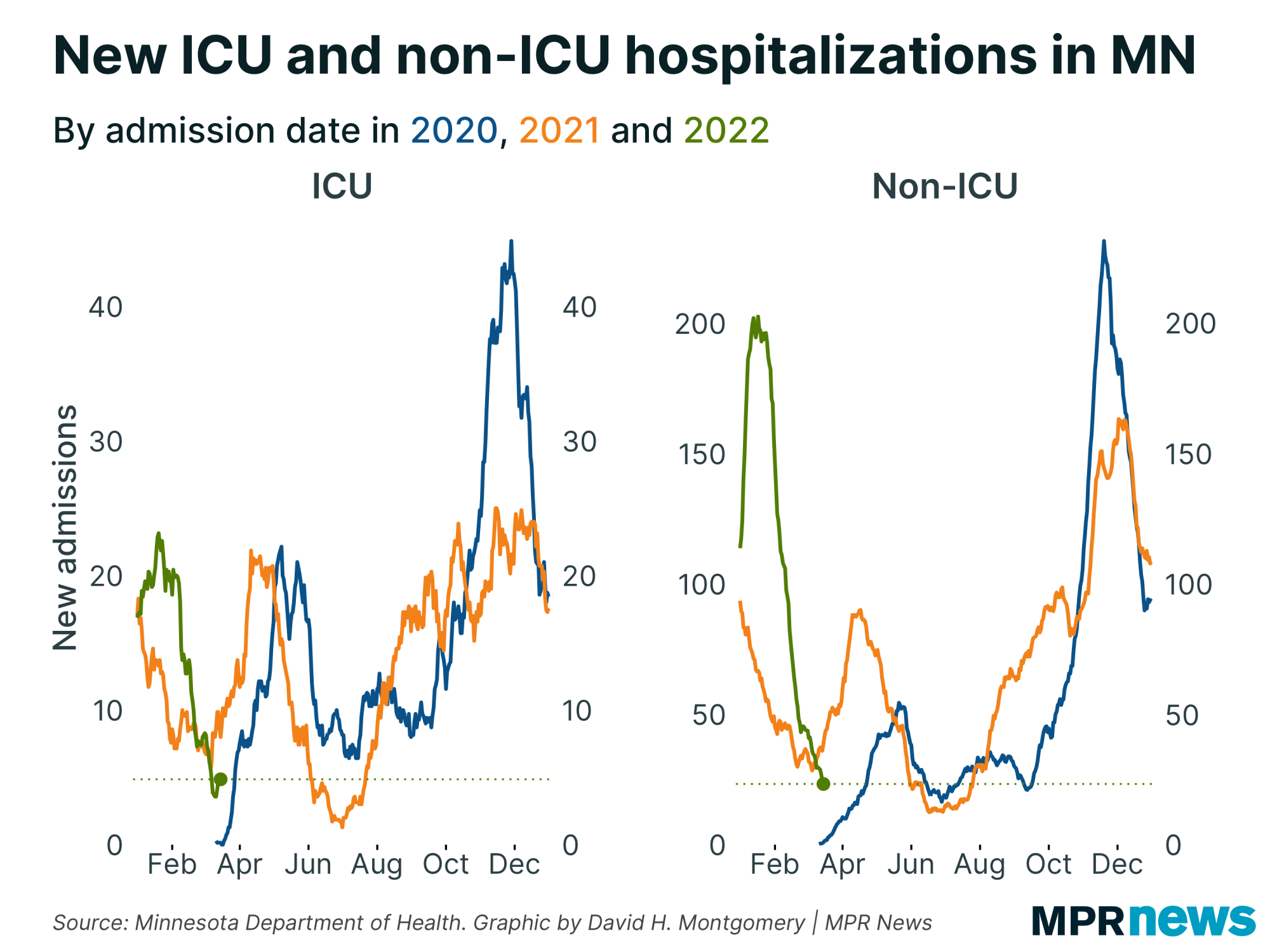Oct. 20 update on COVID-19 in MN: Record jump in hospital admissions; new cases climb

Go Deeper.
Create an account or log in to save stories.
Like this?
Thanks for liking this story! We have added it to a list of your favorite stories.
Updated: 1 p.m.
Minnesota’s COVID-19 numbers continue to trend the wrong way.
The Health Department Tuesday reported 1,120 new cases of the disease, continuing an October trend of new counts averaging more than 1,000 a day. More worrisome: the agency’s data revealed a record number of newly reported COVID-19 hospital admissions.

Tuesday's data showed 126 people admitted to the hospital, a single-day high in the pandemic, with 37 needing intensive care. More than 500 people have been hospitalized over the past week, including 100 ICU cases. The seven-day trend is now close to its late-May peak.
Officials had anticipated seeing an October surge in cases expected from Labor Day weekend gatherings, sporting events and college student meetups at the start of fall semester. They also expected the wave would put more people in the hospital. That appears to be happening.
Turn Up Your Support
MPR News helps you turn down the noise and build shared understanding. Turn up your support for this public resource and keep trusted journalism accessible to all.
Newly confirmed cases of COVID-19 are growing faster than testing, an indication that the spread of the disease is not simply the product of more testing. Active, confirmed cases, which last week topped 10,000 and then jumped this week above 12,000 remain at a record in the pandemic.

New cases reported Tuesday brought the total in the pandemic to 125,531 to date; about 89 percent have recovered to the point they no longer need to be isolated.
Seven newly reported deaths raised Minnesota’s toll to 2,246. Among those who’ve died, about 70 percent had been living in long-term care or assisted living facilities; most had underlying health problems.

The newest numbers come a day after Minnesota officials, seeing rampant spread across the state, strongly suggested people rethink their holiday plans and avoid multifamily celebrations or big gatherings with friends.
Many of the state’s outbreaks are being fueled now by the kinds of informal get-togethers with friends and family that multiply during the November and December holidays. Traditional year-end holiday gatherings may simply may be too risky in a pandemic, Jan Malcolm, the state’s health commissioner, said Monday.

Case counts rising across age groups
New cases are up dramatically over the past month in all age groups. That includes a concerning rise in the number of new cases among Minnesotans ages 60 and older.
People in their 20s still make up the age bracket with the state’s largest number of confirmed cases — more than 28,000 since the pandemic began, including more than 16,000 among people ages 20-24.

The numbers help explain why experts remain particularly concerned about young adults as spreaders of the virus.
While less likely to feel the worst effects of the disease and end up hospitalized, experts worry youth and young adults will spread it to grandparents and other vulnerable populations and that spread could hamper attempts to reopen campuses completely to in-person teaching.
The number of high school-age children confirmed with the disease has also grown, with more than 11,400 total cases among children ages 15 to 19 since the pandemic began.
Cases surging outside the Twin Cities metro area
Regionally, central, northern and southern Minnesota have driven much of the recent increase in new cases while Hennepin and Ramsey counties show some of the slowest case growth in the state.
Collectively, rural areas of Minnesota continue to report the most new COVID-19 cases.
Central Minnesota cases are leaping relative to its population. It’s not clear why. Northern Minnesota, once by far the region least affected by the disease, has also seen its caseload grow dramatically in recent weeks.

Deaths are also spiking in northern and central Minnesota.
Latino, Indigenous cases jump
In Minnesota and across the country, COVID-19 has hit communities of color disproportionately hard in both cases and deaths.
Minnesotans of Hispanic descent are testing positive for COVID-19 at about five times the rate of white Minnesotans. They, along with Black Minnesotans, are also being hospitalized and moved to intensive care units at higher rates than the overall population.
Similar trends hold true for Minnesota’s Indigenous residents. Counts among Indigenous people have jumped in October relative to population.

Data the past two weeks also show newly confirmed cases continuing to accelerate among Latino people in Minnesota.
Distrust of the government, together with deeply rooted health and economic disparities, have hampered efforts to boost testing among communities of color, particularly for unauthorized immigrants who fear their personal information may be used to deport them.
‘We need to take this seriously’
While testing for the disease remains strong, it doesn’t explain the current case growth. Cases are growing more quickly than tests, and the rate of positive tests is continuing to rise above 5 percent, the threshold officials find concerning.

“The transmission is everywhere, not just one or two sources or one or two kinds of settings. It’s the individual decisions that we’re all making fueling the rate of increase we’re seeing,” Malcolm cautioned. “We need to take this seriously.”
With cases outpacing testing levels, “we’re still not able to catch all the disease that’s out there,” Malcolm said. “The rate of viral presence is still very high and growing.”
While surges early in the pandemic were driven largely by illnesses tied to long-term care facilities and workplace sites such as meatpacking plants, officials say the current spread is diffused, making it even harder to trace and isolate cases.

“Going out for happy hour after work with your coworkers or getting together with a bunch of friends that you haven't seen for awhile, all of that seems pretty innocuous. But in reality all of those different interactions can lead to transmission,” Kris Ehresmann, the state’s infectious disease director, told MPR News on Monday.
She said officials are concerned Minnesotans, fatigued by more than seven months of trying to stay vigilant, are letting their guard down in private settings, even as the virus spreads.
Later Monday, Ehresmann said Minnesotans should think about holiday gatherings of 10 or fewer this year instead of big potluck dinners across multiple families.

She and Malcolm again implored Minnesotans to take personal responsibility to stem the spread of the disease, including wearing masks in indoor public spaces, socially distancing and staying home if you feel ill.
Developments around the state
DFL state senator tests positive
A DFL state senator is in the quarantine phase after testing positive for COVID-19.
Sen. Dan Sparks of Austin said he test he took Oct. 8 came back positive. He sought the test after experiencing flu-like symptoms a few days earlier.
Sparks didn’t come to the Capitol for the recent special session and says he’s been doing his work remotely. A few other lawmakers have disclosed their own bouts with the virus since this spring.
— Brian Bakst | MPR News
Osterholm: Next 6-12 weeks will be 'darkest of the entire pandemic'
A University of Minnesota expert on infectious disease said that while coronavirus vaccines are in development, he's predicting that the worst of the pandemic is yet to come.
"The next six to 12 weeks are going to be the darkest of the entire pandemic," Michael Osterholm, director of the Center for Infectious Disease Research and Policy, said Sunday on NBC's "Meet the Press."
"Vaccines will not become available in any meaningful way until early to third quarter of next year and even then half the U.S. population at this point are skeptical even taking the vaccine,” he added.
Osterholm said the trend in case increases is going in the wrong direction heading into winter, and he that the nation still is lacking a strong unified message on how best to combat COVID-19. He said Americans should not plan on traveling to visit relatives for upcoming holidays to prevent the virus from spreading.
— MPR News Staff
Smith tests negative after event attendee gets COVID-19
DFL Sen. Tina Smith said she’s tested negative for the coronavirus after learning someone at a recent campaign event now has COVID-19.
Smith briefly quarantined after learning of the potential exposure. But the senator said she was never in close contact with the person. Masks were required at the outdoor event held more than a week ago.
Smith announced Monday that she had a new test that didn’t detect the virus. She said she would travel back to Washington for Senate proceedings.
— Brian Bakst | MPR News
‘Not just a community problem’
Minnesota health care leaders say they're concerned the rapid spread of the coronavirus will cause staffing problems at clinics and hospitals.
Hennepin Healthcare CEO Jennifer DeCubellis told reporters Friday the problem isn't so much nurses, doctors and other employees being exposed to patients with COVID. She said staff are contracting the virus outside of their workplaces.
"Community spread is not just a community problem — it's a health care problem," she said. "When our workers have exposure or their family members do — just like everybody in the community, they need to quarantine. That takes them out of providing that critical health care service."
DeCubellis said staff exposures to the coronavirus from the community have more than doubled in recent weeks.
— MPR News Staff
Top headlines
St. John's, St. Ben's shift gears to keep students on campus: COVID-19 forced colleges and universities to make major changes this year in the ways students learn and interact — and many students are taking most or even all of their courses online. But in central Minnesota, St. John's University and the College of St. Benedict decided to keep students on campus and in the classroom as much as possible.
MN top health officials on what’s behind the Midwest COVID-19 surge: In Wisconsin, hospitals are at or near capacity following a tripling of coronavirus patients in the last month. North Dakota and South Dakota showed the highest number of cases per capita in the country based on the most recent seven-day average. Minnesota set its own record for new cases on Friday, and hospitalizations and deaths in the state continue to rise.
Anoka’s huge Halloween festival returns to its roots amid pandemic: This year marks a century of Halloween celebrations for the Twin Cities suburb. While COVID-19 is forcing Anoka to rein in many of its traditions, the 2020 festival has not been canceled. Here’s what the “Halloween Capital of the World” has planned.
COVID-19 cases tied to MN campaign events — but full impact is unclear: Sixteen cases stemmed from President Donald Trump’s Sept. 18 rally in Bemidji — and four more from the protests outside. So far, only three cases have been traced to Trump’s Sept. 30 rally in Duluth. And one case has been connected to Democratic challenger Joe Biden’s campaign stop at a union training center in Duluth.
COVID-19 in Minnesota
Data in these graphs are based on the Minnesota Department of Health's cumulative totals released at 11 a.m. daily. You can find more detailed statistics on COVID-19 at the Health Department website.


